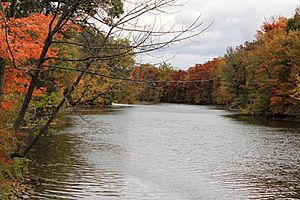Newaygo, Michigan facts for kids
Quick facts for kids
Newaygo, Michigan
|
|
|---|---|

Location of Newaygo, Michigan
|
|
| Country | United States |
| State | Michigan |
| County | Newaygo |
| Area | |
| • Total | 3.92 sq mi (10.16 km2) |
| • Land | 3.77 sq mi (9.75 km2) |
| • Water | 0.15 sq mi (0.40 km2) |
| Elevation | 692 ft (211 m) |
| Population
(2020)
|
|
| • Total | 2,471 |
| • Density | 656.13/sq mi (253.35/km2) |
| Time zone | UTC-5 (Eastern (EST)) |
| • Summer (DST) | UTC-4 (EDT) |
| ZIP code |
49337
|
| Area code(s) | 231 |
| FIPS code | 26-57080 |
| GNIS feature ID | 1621003 |
Newaygo (pronounced nə-WAY-goh) is a small city in Newaygo County, Michigan. It's located in the U.S. state of Michigan. In 2020, about 2,471 people lived there. Newaygo is known for its natural beauty and connection to the Muskegon River.
Contents
Exploring Newaygo's Geography
Newaygo is located in West Michigan. The city covers about 3.90 square miles (10.16 square kilometers). Most of this area is land, but about 0.16 square miles (0.40 square kilometers) is water. The famous Muskegon River flows right through the town. This river is a popular spot for fun activities like canoe trips, tubing, and fishing.
Important Waterways
The Muskegon River is a key feature of Newaygo. It runs along the north side of the city.
Main Roads in Newaygo
Two main highways pass through Newaygo:
 M-37
M-37 M-82
M-82
Newaygo's Past: A Look at History
Newaygo's history goes back to the 1600s. French fur traders, called coureur des bois and voyageurs, traveled through the area. They used canoes on the Muskegon River. The city was likely named after Chief Nuwagon. He was an Ojibwe leader who signed an important agreement in 1819. Another idea is that the name comes from an Algonquian word meaning "much water."
In 1836, John Brooks arrived to cut down trees for lumber. He became the town's first postmaster in 1847. Because it was so close to the river, Newaygo became a center for the lumber industry. Logs were floated down the river to mills in Muskegon during the late 1800s.
Understanding Newaygo's Population
The word "demographics" helps us understand the people who live in a place. It looks at things like how many people there are and how old they are.
| Historical population | |||
|---|---|---|---|
| Census | Pop. | %± | |
| 1870 | 703 | — | |
| 1880 | 1,097 | 56.0% | |
| 1890 | 1,330 | 21.2% | |
| 1900 | 1,172 | −11.9% | |
| 1910 | 1,207 | 3.0% | |
| 1920 | 1,160 | −3.9% | |
| 1930 | 1,227 | 5.8% | |
| 1940 | 1,282 | 4.5% | |
| 1950 | 1,385 | 8.0% | |
| 1960 | 1,447 | 4.5% | |
| 1970 | 1,381 | −4.6% | |
| 1980 | 1,271 | −8.0% | |
| 1990 | 1,336 | 5.1% | |
| 2000 | 1,670 | 25.0% | |
| 2010 | 1,976 | 18.3% | |
| 2020 | 2,471 | 25.1% | |
| U.S. Decennial Census | |||
Population in 2010
In 2010, Newaygo had 1,976 people living in 786 households. About 36.8% of households had children under 18. The average age in the city was 32.4 years. About 29.3% of residents were under 18 years old.
Newaygo's Climate
Newaygo has a "Humid Continental Climate." This means it has warm summers and cold, snowy winters.
Famous People from Newaygo
Many interesting people have come from Newaygo, including:
- Ella H. Brockway Avann (born 1853), an educator
- Roy Bargy, a composer and pianist
- Joe Berger, a football player for the Minnesota Vikings
- Jack Nitzsche, a musician and arranger
- Bertha Yerex Whitman, an architect
Images for kids
See also
 In Spanish: Newaygo para niños
In Spanish: Newaygo para niños




